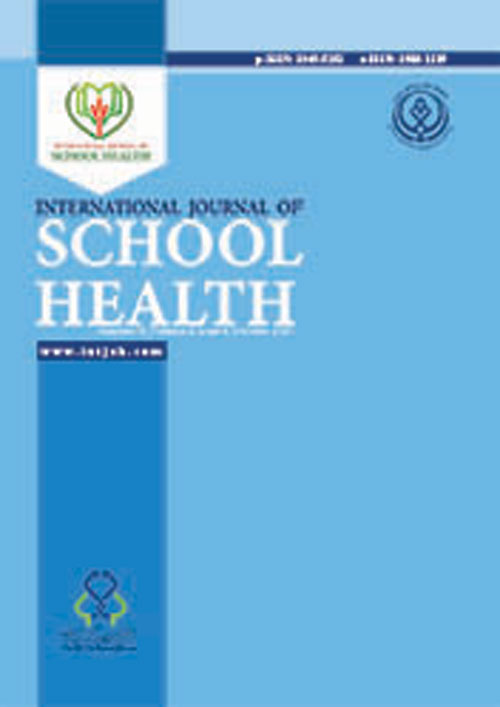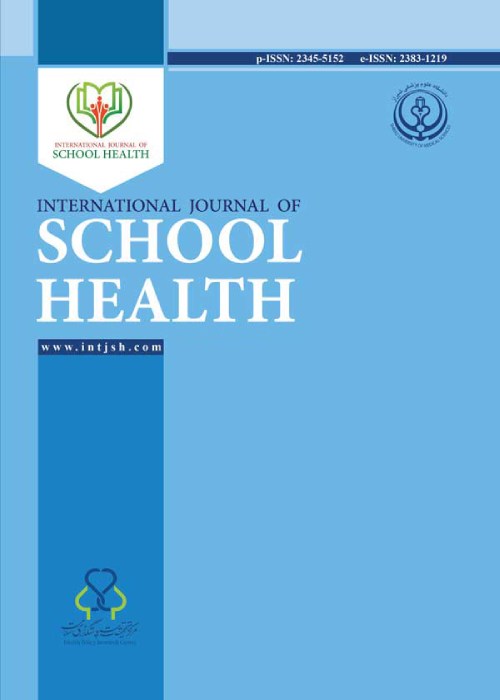فهرست مطالب

International Journal of School Health
Volume:5 Issue: 2, Spring 2018
- تاریخ انتشار: 1397/02/19
- تعداد عناوین: 6
-
-
Page 1BackgroundOne of the most important goals of physical education teachers and sport trainers is to increase the amount of learning and performance of motor skills of students and athletes in the shortest time, with the lowest cost and energy, and the highest level of motor skills learning. Therefore, teachers and sport coaches should use the best methods to learn and practice for better results.ObjectivesThe purpose of this study was to investigate the effect of motivational self-talk on the performance and learning of skills of throwing a tennis ball from the top of the shoulders with the use of the non-dominant hand in 10-year old male students.MethodsFor this purpose, 40 male students (average age of 10. 17 ± 0.51) volunteered to participate in this study as the research sample and were randomly divided to 2 groups of 20 (motivational self-talk group and control group). In the acquisition phase, the subjects were trained continuously during 5 sessions for 5 days (6 blocks of 10 attempts per session) and on the next day, they performed a retention test with 10 attempts.
To illustrate the difference between groups, independent samples t-test was used, while one-way analysis of variance was used to compare the scores of each group at each phase of study.ResultsThe results of the statistical methods showed that both groups improved at the acquisition stage and there was a significant difference between the groups at the acquisition stage (PConclusionsIn general, it is suggested for sports teachers and trainers to use motivational self-talk for improvement of various skills.Keywords: Motivational Self, Talk, Learning, Children, Non, Dominant Hand, Throwing From the Top of The Shoulder -
Page 2BackgroundThe concept of educational stress is considered an important construct in education and has attracted the attention of many researchers.ObjectivesThis research was conducted with the goal of investigating validity, reliability, and factor structure of Sun, Dunne, Hou and Xu educational stress scale in Iranian high school students.MethodsBy using random cluster sampling, 300 high school students (male and female) were selected from Babolsar city as participants for this research. Participants completed the educational stress scale and data were analyzed using Amos (v. 22) and SPSS (v. 22) software. Factor analysis was performed by exploratory and confirmatory analysis.ResultsThe results of factor analysis revealed the presence of 4 dimensions (workload and pressure from study, self-expectation, worry about grades, and despondency). The internal consistency estimate of reliability for this scale and subscales were in the range of 0.63 to 0.80.ConclusionsThe results illustrated that this scale has goodness of fit and could be applied in related research.Keywords: Factor Analysis, Reliability, Validity, Educational Stress
-
Page 3BackgroundTeaching at schools are perceived stressful and a number of teachers in many countries leave school due to stressful conditions. Facing stressful conditions in the long term may cause teachers to experience a burnout. The purpose of this study was to examine the prediction of burnout in primary and secondary teachers based on various stressful conditions at the school workplace, such as personal stressors, professional distress, discipline and motivation, emotional manifestations, behavioral manifestations, as well as physiological fatigue manifestations.MethodsA total of 107 elementary and high school teachers participated in this study. They were recruited from different schools in Zarrin - Dasht - Fars, using convenience sampling. The teachers were chosen from a total of 6 schools. Participants completed the teacher stress inventory (TSI) and Maslach Burnout Inventory (MBI). The TSI consists of 49 items measuring stress - related problems. The MBI comprised of 22 and assess 3 dimension including emotional exhaustion, depersonalization, and lack of a sense of personal achievement. The mean, standard deviations, frequency, percentage, and multiple regression analysis were used to analyze data using SPSS (version 18).ResultsFindings showed that the majority of teachers experienced work - related stress. The highest degree of stress was related to professional distress (M = 3.48) followed by personal distress (M = 2.92), discipline as well as motivation (M = 2.28), job involvement (M = 2.22), and time management (M = 2.15). Male teachers experienced more occupational stress than female teachers. Those with more years of experience also had a higher level of burnouts. Findings indicated that age, job involvement, emotional manifestation, discipline, and professional distress significantly predicted burnouts among the teachers in the study, while other independent variables such as personal distress and time management did not predict the burnout.ConclusionsThis study indicated that a large proportion of the teachers experienced occupational stress. Findings also showed that professional stress or work-related stress was the most important stressors as perceived by the teachers. The findings of this research confirm the significance of teaching related stress as a factor influencing teachers well - being.Keywords: Stress, Teacher, Burnout, School
-
Page 4BackgroundThe menstrual cycle determines the health of women. Menstrual disorders are a major Geneologic problem among women, especially adolescents, which is a major source of anxiety for them and their families. Factors such as BMI, exercise, and stress can be related to menstrual disorders. As a result, this study was conducted to determine the association between menstrual disorders and anthropometric indices in Female High School Students.MethodsThis descriptive cross-sectional study was conducted in Sabzevar on 200 high school female students in 2017. The participants first completed the personal, midwifery, and family profile questionnaire. Finally, anthropometric indicators were measured. Data analysis was done using SPSS 16 software and Mann-Whitney test.ResultsThe results of the study showed that oligomenorrhea with weight (p = 0.03), arm circumference (P = 0.03), BMI (P = 0.03), hypermenorrhea with waist circumference (P = 0.01), hypomenorrhea with height (P = 0.04), menorrhagia with waist circumference (P = 0.002), polymenorrhea with weight (P = 0.01), arm circumference (P = 0.04), Body mass index (p = 0.01) and metrorrhagia with weight (P = 0.01), hip circumference (P = 0.007), waist circumference (P = 0.004), and hip circumference (P = 0.01) have a significant association.ConclusionsThe results of this study showed that some anthropometric indices associated with menstrual disorders in female high school students. According to the results of this study, it seems that having a suitable lifestyle can prevent these disorders.Keywords: Menstrual disorders, Anthropometric Indices, Menstruation
-
Page 5BackgroundResearch on body image objectification in Nigeria is scanty, particularly with regards to disordered eating attitudes. Thus, this study examined the relationship between the 2 constructs among secondary school students in the country.MethodsOverall, 270 students were selected through convenience sampling from 3 schools randomly selected from a local government area in South West Nigeria, and completed a questionnaire containing the 26-item eating attitudes test (EAT-26) and objectified body consciousness scale (OBCS). The students were classified to 2 groups using the EAT-26 cut-off point of 20, and the differences in the mean scores of the 3 sub-scales of OBCS were determined between the groups.ResultsThere were more females than males (56.7% vs. 43.3%) with a mean age of 16.1 years. Eighty-five students scored above the cut-off point of 20, thus, prevalence rate of disordered eating attitudes was 31.5%. There was no significant association between the socio-demographic variables and disordered eating attitudes. The appearance control belief (a subscale of OBCS) was significantly lower in students with disordered eating attitudes (t = 2.18, P = 0.03), whereas, the remaining 2 subscales of OBCS was not significantly associated with disordered eating attitudes.ConclusionsAppearance control belief seems to be the most important in the eating attitudes of Nigerian adolescents in self-objectification. However, more research is needed to shed more light on this matter.Keywords: Appearance Control Belief, Disordered Eating, Nigeria, Self, Objectification
-
Page 6BackgroundEnvironmental variables are one of the main factors affecting stress. This research aimed to determine environmental factors affecting students stress in the educational environment in Shiraz, Iran, in the framework of survey research.MethodsThe study included a sample of 246 female high school students who were selected by multi-stage cluster sampling from a Shiraz-based educational district. As a tool for collecting data, a questionnaire was prepared by reviewing the relevant literature and in accordance with the research objectives. Cronbachs alpha coefficient was calculated to determine the reliability of the questionnaire, which was equal to 0.72, showing a good reliability. The content validity of the questionnaire was also verified by experts and faculty related to the subject. In order to investigate the construct validity, after examining the internal consistency of the questions, the questionnaire was analyzed using the main components method. Based on the results of factor analysis, four factors including thermal comfort, physical factors, environmental interventions, and security were extracted. Data analysis was done by SPSS 21. The effect of environmental factors on student stress was investigated using one-sample T-test for each of the factors. In addition, Friedman test was used to study the importance of the environmental factors referring to each other.ResultsFrom the viewpoint of students, thermal comfort (P valueConclusionsEnvironmental factors such as environmental interveners, thermal comfort, physical factors, and security could affect female high school students stress expressed in the order of importance. They should be taken into consideration by designers of educational spaces.Keywords: Stress, Ambient Stressors, Educational Environment, Thermal Comfort, Physical Factors, Security, Environmental Interveners


